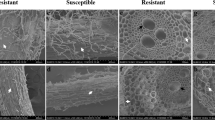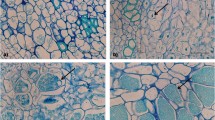Summary
Natural senescence of the root cortex was assessed by nuclear staining, for cultivars and chromosome substitution lines of spring wheat known to differ in (1) susceptibility to common root rot, (2) total rhizosphere populations and (3) ability to support growth of a free-living nitrogen-fixing bacterium.
Together, three root rot susceptible wheat lines showed significantly more cortical senescence than did three resistant lines; the susceptible lines also support larger rhizosphere populations. The wheat line that supports growth of a nitrogen-fixing bacterium showed significantly less cortical death than did any other line. Substitution of chromosome pairs 5B or 5D between the parent cultivars Rescue and Cadet substantially altered the amount of root cortex death, which is thus genetically determined. It is suggested thatCochliobolus sativus and other weak parasites benefit from early natural senescence of the root cortex, and that the degree of susceptibility or resistance of wheat lines to common root rot is at least partly determined by differences in cortical senescence.
Similar content being viewed by others
References
Atkinson T G, Neal J L and Larson R I 1974 Root rot reaction in wheat: resistance not mediated by rhizosphere or laimosphere antagonists. Phytopathology 64, 97–101.
Atkinson T G, Neal J L and Larson R I 1976 Genetic control of the rhizosphere microflora of wheat.In Biology and Control of Soilborne Plant Pathogens. Ed. G W Bruehl American Phytopathological Society. St. Paul. Minnesota.
Deacon J W 1980 Ectotrophic growth byPhialophora radicicola var.graminicola and similar parasites of cereal and grass roots. Trans. Br. mycol. Soc. 75, 158–160.
Deacon J W and Henry C M 1980 Age of wheat and barley roots and infection byGaeumannomyces graminis var.tritici. Soil Biol. Biochem. 12, 113–118.
Deacon J W and Henry C M 1981 Death of the root cortex of winter wheat in field conditions; effects of break crops and possible implications for the take-all fungus and its biological control agent,Phialophora radicicola var.graminicola. J. Agric. Sci. Camb. 96, 579–585.
Henry C M, and Deacon J W 1981 Natural (non-pathogenic) death of the cortex of wheat and barley seminal roots, as evidenced by nuclear staining with acridine orange. Plant and Soil 60, 255–274.
Holden J 1975 Use of nuclear staining to assess rates of cell death in cortices of cereal roots. Soil Biol. Biochem. 7, 333–334.
Holden J 1976 Infection of wheat seminal roots by varieties ofPhialophora radicicola andGaeumannomyces graminis. Soil. Biol. Biochem. 8, 109–119.
Larson R I and Atkinson T G 1970 A cytogenetic analysis of reaction to common root rot in some hard red spring wheats. Can. J. Bot. 48, 2059–2067.
Larson R I and Neal J L 1978 Selective colonization of the rhizosphere of wheat by nitrogen-fixing bacteria. Ecol. Bull. (Stockholm) 26, 331–342.
Neal J L and Larson R I 1976 Acetylene reduction by bacteria isolated from the rhizosphere of wheat. Soil Biol. Biochem. 8, 151–155.
Neal J L, Larson R I and Atkinson T G 1973 Changes in rhizosphere populations of selected physiological groups of bacteria related to substitution of specific pairs of chromosomes in spring wheat. Plant and Soil 39, 209–212.
van Vuurde J W L and Schippers B 1980 Bacterial colonization of seminal wheat roots. Soil Biol. Biochem. 12, 559–565.
Author information
Authors and Affiliations
Rights and permissions
About this article
Cite this article
Deacon, J.W., Lewis, S.J. Natural senescence of the root cortex of spring wheat in relation to susceptibility to common root rot (Cochliobolus sativus) and growth of a free-living nitrogen-fixing bacterium. Plant Soil 66, 13–20 (1982). https://doi.org/10.1007/BF02203397
Received:
Issue Date:
DOI: https://doi.org/10.1007/BF02203397




